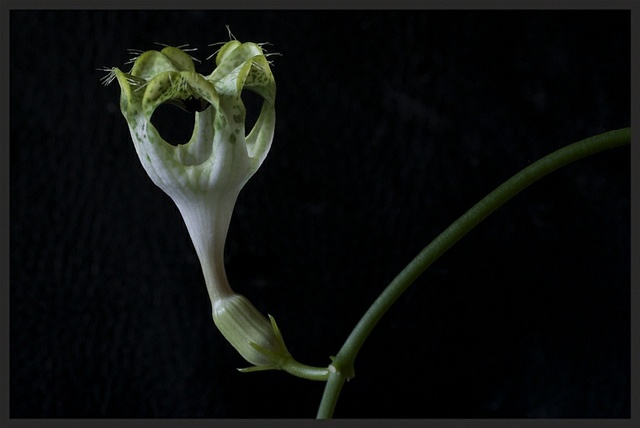Parachute flower smells like a tasty bee in distress
Flowers of the African parachute plant are deceivers, as Annemarie Heiduk and colleagues show. The flowers mimic the smell of honeybees that are caught in the jaws of a spider. Their volatiles attract flies that feed on the fluids that such unhappy bees excrete. These flies pollinate the flowers.
Many plants have their flowers pollinated by insects. The insects take up pollen from one flower they visit and leave some of it on the pistil of the next flower, that can then grow seeds. And in return, most plants offer their pollinators nectar as a reward.
Clumps of pollen
But not all plants are honest plants. Some lure their pollinators with false promises of a reward.
A sophisticated deceptive plant is the African parachute plant Ceropegia sandersonii, a climbing herb from southern Africa, as Annemarie Heiduk and colleagues reveal.
Its pollinators are Desmometopa-flies. They visit the flowers and disperse the pollen, but not voluntarily. The flower is a trap where they go into. Downward pointing hairs on the flower wall make it impossible for them to get out. Clumps of pollen (pollinaria) within the flower dislodge and stick to their mouthparts.
Only the next day, when the flower withers, the flies are able to escape, packed with pollen. In the flower that they enter next, they will deposit the pollinaria unwittingly on the right place.
The question arises: how is it that the flies can be tricked time and again? Now, Heiduk answered that question: the flower smells like their food.
Volatiles
The flies, especially the females, need protein and they derive it from honeybees. They can’t overpower a honeybee by themselves, as they are much smaller. But when a spider has caught one, they come and feed on the fluids that leak from the dying bee. They find such a bee as they detect compounds that are released from its mandible glands and sting glands when it tries to defend itself by biting or stabbing. Also, they detect the pheromones that the bee releases to alert conspecifics.
Heiduk analysed the blend of volatiles dispersed by the flowers of the parachute plant, and found that many components are identical to the compounds that are released by bees in agony. This blend of volatiles is unique among flowering plants, and clearly adapted to lure the flies. Upon detection, they approach the flower, expecting to find a helpless bee. They find nothing of the kind, however, but are imprisoned for a time and meanwhile serve the plant. For free.
Willy van Strien
Photograph: Ceropegia sandersonii. Alzheimer1 (via Flickr. Creative Commons BY-NC-SA 2.0)
Nasty video: a honeybee is hold by a spider and licked by Desmometopa-flies
Source:
Heiduk, A., I. Brake, M. von Tschirnhaus, M. Göhl, A. Jürgens, S.D. Johnson, U. Meve & S. Dötterl, 2016. Ceropegia sandersonii mimics attacked honeybees to attract kleptoparasitic bees for pollination. Current Biology, online October 6. Doi: 10.1016/j.cub.2016.07.085
